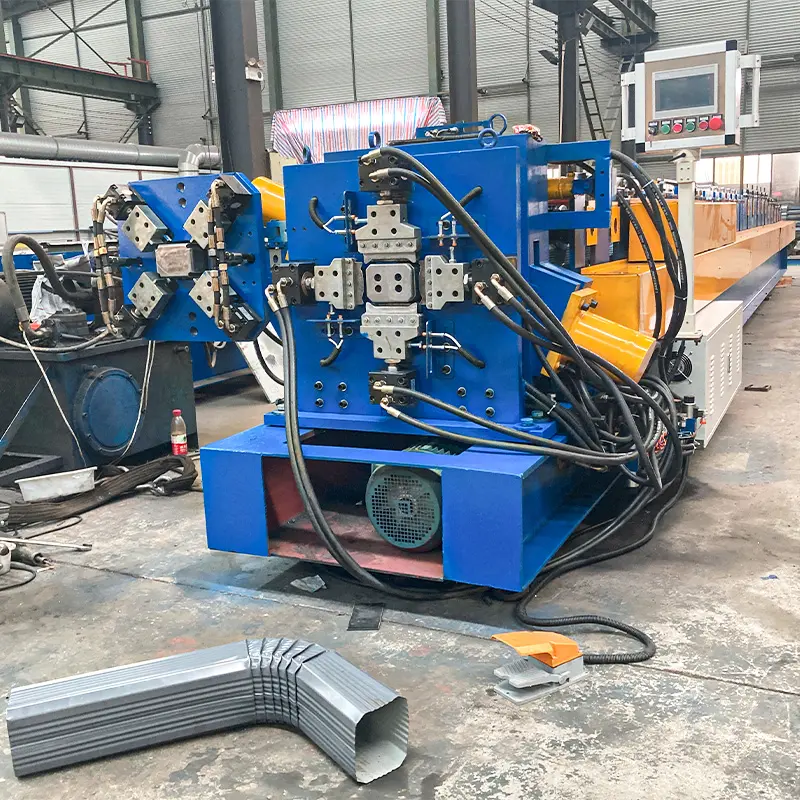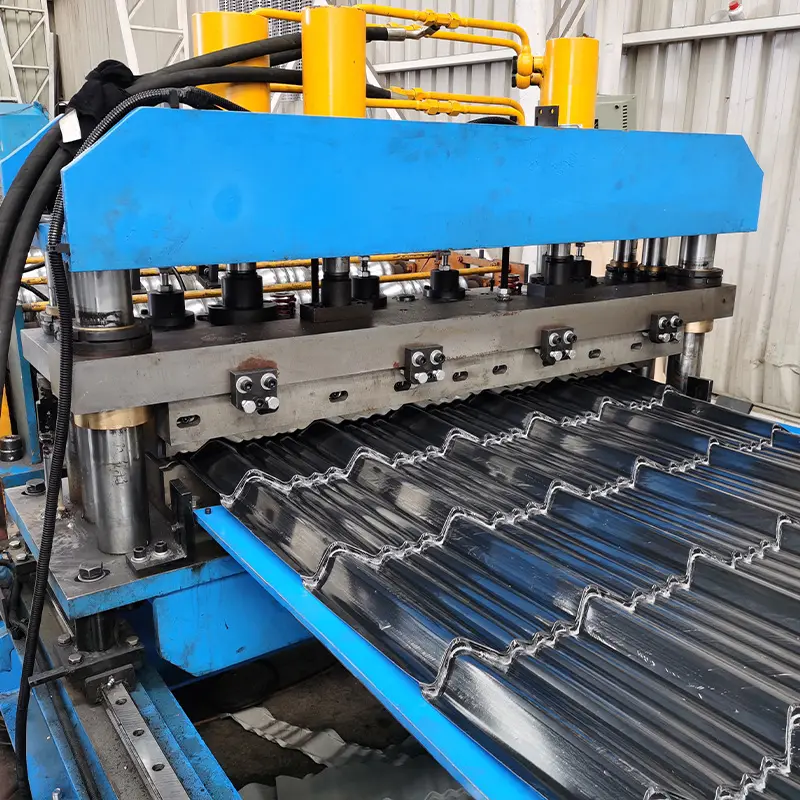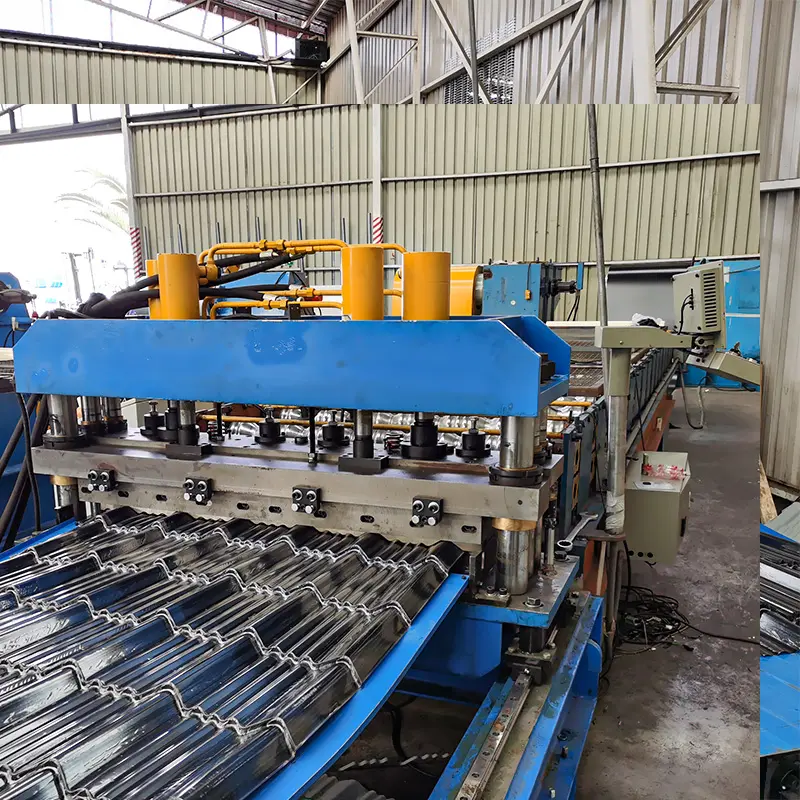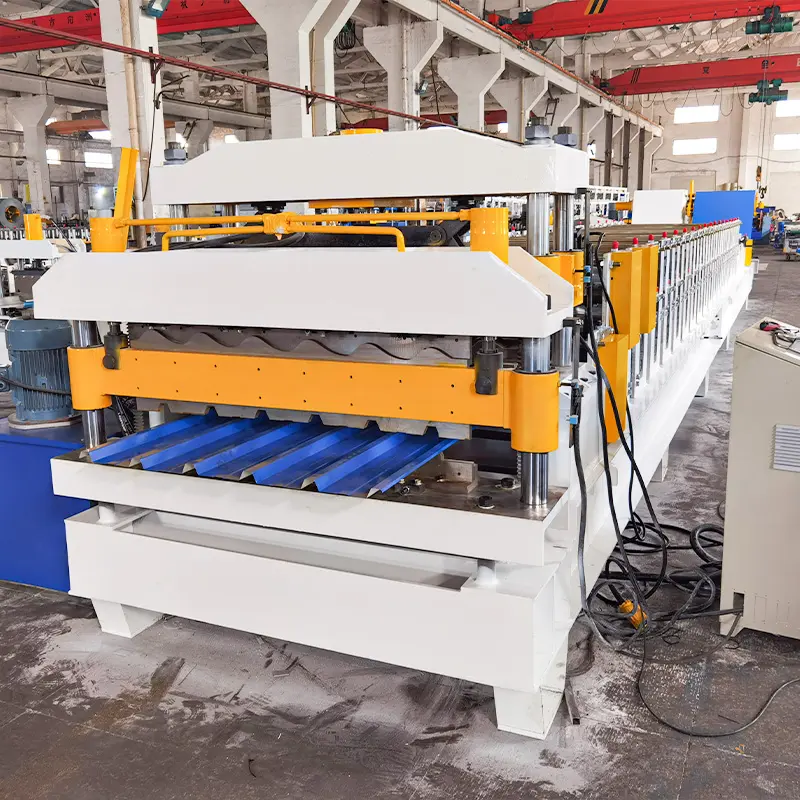ভূমিকা
দ্য অ্যাঙ্গেল রোল ফর্মিং মেশিন বিভিন্ন শিল্পে ধাতুর অ্যাঙ্গেল আকার দেওয়া এবং বাঁকানোর জন্য ব্যাপকভাবে ব্যবহৃত একটি বহুমুখী এবং দক্ষ যন্ত্র। এই নিবন্ধটি অ্যাঙ্গেল রোল ফর্মিং মেশিনের ব্যাপক ওভারভিউ প্রদান করার লক্ষ্যে রচিত, যাতে তাদের প্রয়োগ, সুবিধা, বিবেচনা করার গুরুত্বপূর্ণ বৈশিষ্ট্য, রক্ষণাবেক্ষণ টিপস এবং কার্যকারিতা সর্বোচ্চ করার উপায়গুলি অন্তর্ভুক্ত রয়েছে।

অ্যাঙ্গেল রোল ফর্মিং মেশিন কী?
অ্যাঙ্গেল রোল ফর্মিং মেশিন, যা অ্যাঙ্গেল বেন্ডিং মেশিন বা অ্যাঙ্গেল রোলার নামেও পরিচিত, ধাতুর অ্যাঙ্গেলকে বাঁকানো বা নির্দিষ্ট প্রোফাইল আকারে রূপান্তর করার জন্য বিশেষভাবে নকশাকৃত একটি যন্ত্র। এটি একাধিক রোলারের সিরিজ ব্যবহার করে ধাতুকে ধাপে ধাপে বাঁকায়, সমতল বা সরল অ্যাঙ্গেলকে কাস্টম-ফর্মড প্রোফাইলে রূপান্তরিত করে। নির্মাণ, নির্মাণ এবং অটোমোটিভ শিল্পে এগুলি সাধারণত ব্যবহৃত হয় বিভিন্ন অ্যাঙ্গেল প্রোফাইল নির্ভুলতা এবং দক্ষতার সাথে তৈরি করার জন্য।
অ্যাঙ্গেল রোল ফর্মিং মেশিনের প্রয়োগ
নির্মাণ শিল্প
নির্মাণ শিল্পে অ্যাঙ্গেল রোল ফর্মিং মেশিনগুলি বিভিন্ন কাঠামোগত উপাদানে ব্যবহৃত ধাতুর অ্যাঙ্গেল তৈরিতে গুরুত্বপূর্ণ ভূমিকা পালন করে। এই মেশিনগুলি ছাদের ট্রাস, জানালার ফ্রেম, দরজার ফ্রেম, ইস্পাতের বিম এবং সাপোর্টের মতো প্রয়োগের জন্য অ্যাঙ্গেল প্রোফাইল উৎপাদন করতে পারে। প্রকল্পের স্পেসিফিকেশন অনুসারে অ্যাঙ্গেল প্রোফাইল কাস্টমাইজ করার ক্ষমতা নির্মাণ খাতে এই মেশিনগুলিকে অত্যন্ত জনপ্রিয় করে তোলে।
অটোমোটিভ শিল্প
অ্যাঙ্গেল রোল ফর্মিং মেশিনগুলি অটোমোটিভ শিল্পে ব্যাপকভাবে ব্যবহৃত হয় কার্বড বা বিশেষ আকৃতির অ্যাঙ্গেল প্রয়োজনীয় অংশ এবং উপাদান উৎপাদনের জন্য। এই মেশিনগুলি চ্যাসিস ফ্রেম, সিট ফ্রেম, বাম্পার, রোল বার এবং নিষ্কাশন সিস্টেমে ব্যবহৃত অ্যাঙ্গেল প্রোফাইল তৈরি করতে ব্যবহার করা হয়। অ্যাঙ্গেল রোল ফর্মিং মেশিনের নির্ভুলতা এবং পুনরাবৃত্তিযোগ্যতা উৎপাদিত উপাদানের সামঞ্জস্যপূর্ণ গুণমান এবং ফিটমেন্ট নিশ্চিত করে।
উৎপাদন খাত
অ্যাঙ্গেল রোল ফর্মিং মেশিনগুলি উৎপাদন খাতে ব্যাপকভাবে ব্যবহৃত হয় বিভিন্ন পণ্য উৎপাদনের জন্য যা বাঁকানো বা কার্ভড অ্যাঙ্গেল প্রয়োজন। আসবাবপত্র উৎপাদন, যন্ত্রপাতি উৎপাদন, এইচভিএসি সিস্টেম এবং শেল্ফিং সিস্টেমের মতো শিল্পগুলি তাদের সংশ্লিষ্ট পণ্যে ব্যবহৃত অ্যাঙ্গেল প্রোফাইল তৈরি করতে অ্যাঙ্গেল রোল ফর্মিং মেশিনের উপর নির্ভর করে। অ্যাঙ্গেল রোল ফর্মিং মেশিনের নমনীয়তা এবং অভিযোজনক্ষমতা উৎপাদকদের নির্দিষ্ট ডিজাইন প্রয়োজনীয়তা দক্ষতার সাথে পূরণ করতে সক্ষম করে।
অ্যাঙ্গেল রোল ফর্মিং মেশিন ব্যবহারের সুবিধাসমূহ
খরচ সাশ্রয়
অ্যাঙ্গেল রোল ফর্মিং মেশিন ব্যবহার করলে উৎপাদন প্রক্রিয়ায় উল্লেখযোগ্য খরচ সাশ্রয় সম্ভব। ম্যানুয়াল লেবার-নিবিড় বাঁকানো প্রক্রিয়ার প্রয়োজনীয়তা দূর করে বা হ্রাস করে, মেশিনটি উৎপাদনশীলতা বাড়ায় এবং শ্রম খরচ কমায়। এছাড়া, অ্যাঙ্গেল রোল ফর্মিং মেশিনগুলি নির্ভুল বাঁকা অর্জন করে এবং ত্রুটি বা পুনর্কাজের সম্ভাবনা হ্রাস করে উপাদানের অপচয় কমায়।
কাস্টমাইজেশন এবং বহুমুখিতা
অ্যাঙ্গেল রোল ফর্মিং মেশিনের মূল সুবিধাগুলির মধ্যে একটি হলো কাস্টমাইজড অ্যাঙ্গেল প্রোফাইল উৎপাদনের ক্ষমতা। উৎপাদকরা বিভিন্ন আকার, আকৃতি এবং মাত্রার অ্যাঙ্গেল তৈরি করতে মেশিন সেটিংস সহজেই সামঞ্জস্য করতে পারেন, যা নির্দিষ্ট প্রকল্পের প্রয়োজনীয়তা পূরণে বহুমুখিতা প্রদান করে। এই নমনীয়তা ঐতিহ্যবাহী বাঁকানো পদ্ধতি ব্যবহার করে অর্জন করা কঠিন অনন্য এবং জটিল অ্যাঙ্গেল প্রোফাইল উৎপাদন সক্ষম করে।
উচ্চ দক্ষতা এবং উৎপাদনশীলতা
অ্যাঙ্গেল রোল ফর্মিং মেশিনগুলি উচ্চ-গতির উৎপাদনের জন্য ডিজাইন করা হয়েছে, যা দক্ষ উৎপাদন প্রক্রিয়া সক্ষম করে। এই মেশিনগুলি ধাতব অ্যাঙ্গেল দ্রুত এবং নির্ভুলভাবে বাঁকাতে পারে, যা ম্যানুয়াল বাঁকানো পদ্ধতির তুলনায় উচ্চতর উৎপাদনশীলতা প্রদান করে। অ্যাঙ্গেল রোল ফর্মিং মেশিনের স্বয়ংক্রিয় প্রকৃতি মানুষীয় ত্রুটির ঝুঁকি হ্রাস করে, সামঞ্জস্যপূর্ণ গুণমান নিশ্চিত করে এবং পুনর্কাজ বা সংশোধনের প্রয়োজনীয়তা কমায়।

অ্যাঙ্গেল রোল ফর্মিং মেশিন নির্বাচনের সময় বিবেচনা করার বৈশিষ্ট্যসমূহ
আপনার নির্দিষ্ট প্রয়োজনের জন্য অ্যাঙ্গেল রোল ফর্মিং মেশিন নির্বাচন করার সময় কয়েকটি গুরুত্বপূর্ণ বৈশিষ্ট্য বিবেচনা করা উচিত:
উপাদান সামঞ্জস্যতা
বিভিন্ন অ্যাঙ্গেল রোল ফর্মিং মেশিন নির্দিষ্ট ধরন এবং পুরুত্বের ধাতু হ্যান্ডেল করার জন্য ডিজাইন করা হয়েছে। আপনার কাজ করার উদ্দেশ্যে উপযোগী উপাদানের সাথে সামঞ্জস্যপূর্ণ মেশিন নির্বাচন করা অত্যন্ত জরুরি। মেশিন নির্বাচনের সময় ধাতুর গেজ, টেনসাইল শক্তি এবং উপাদানের ধরন (যেমন, ইস্পাত, অ্যালুমিনিয়াম, স্টেইনলেস স্টিল) বিবেচনা করুন।
রোল ফর্মিং ক্যাপাসিটি
মেশিনের রোল ফর্মিং ক্যাপাসিটি এটি উৎপাদন করতে পারে এমন অ্যাঙ্গেলের সর্বোচ্চ আকার এবং পুরুত্ব নির্ধারণ করে। প্রয়োজনীয় অ্যাঙ্গেলের মাত্রা মূল্যায়ন করুন এবং নিশ্চিত করুন যে মেশিন তার রোল ফর্মিং ক্যাপাসিটির মধ্যে তা সমর্থন করতে পারে।
নিয়ন্ত্রণ ব্যবস্থা
অ্যাঙ্গেল রোল ফর্মিং মেশিন দক্ষতার সাথে পরিচালনার জন্য নির্ভরযোগ্য এবং ব্যবহারকারী-বান্ধব নিয়ন্ত্রণ ব্যবস্থা অত্যন্ত গুরুত্বপূর্ণ। স্বজ্ঞাত নিয়ন্ত্রণ, ডিজিটাল ডিসপ্লে এবং প্রোগ্রামযোগ্য সেটিংসযুক্ত মেশিন খুঁজুন যাতে উৎপাদন প্রক্রিয়া সরলীকৃত হয় এবং দ্রুত সেটআপ এবং সামঞ্জস্য সহজ হয়।
নিরাপত্তা বৈশিষ্ট্যসমূহ
যেকোনো যন্ত্রের মতো অ্যাঙ্গেল রোল ফর্মিং মেশিন পরিচালনার সময় নিরাপত্তা সর্বোচ্চ অগ্রাধিকার পাওয়া উচিত। জরুরি স্টপ বোতাম, নিরাপত্তা ইন্টারলক এবং গার্ডসহ নিরাপত্তা বৈশিষ্ট্যযুক্ত মেশিন নির্বাচন করুন যাতে অপারেটরের কল্যাণ নিশ্চিত হয় এবং দুর্ঘটনা বা আঘাত প্রতিরোধ হয়।
অ্যাঙ্গেল রোল ফর্মিং মেশিনের রক্ষণাবেক্ষণ এবং যত্ন
অ্যাঙ্গেল রোল ফর্মিং মেশিনের দীর্ঘায়ু এবং সর্বোত্তম কর্মক্ষমতা নিশ্চিত করতে সঠিক রক্ষণাবেক্ষণ এবং যত্ন অপরিহার্য। এখানে কয়েকটি মূল রক্ষণাবেক্ষণ অনুশীলন দেওয়া হলো:
নিয়মিত পরিষ্কার এবং লুব্রিকেশন
পরিচালনার সময় জমা হতে পারে এমন ধুলো, ধ্বংসাবশেষ এবং ধাতুর ছোট টুকরো অপসারণ করতে মেশিনটি নিয়মিত পরিষ্কার করুন। ঘর্ষণ, ক্ষয় এবং সম্ভাব্য মারাত্মক ত্রুটি প্রতিরোধ করতে প্রস্তুতকারকের সুপারিশ অনুসারে চলমান অংশগুলিতে লুব্রিকেট করুন।
অংশগুলির পরিদর্শন এবং প্রতিস্থাপন
মেশিনের উপাদানগুলি পর্যায়ক্রমে পরীক্ষা করুন ক্ষয়, ক্ষতি বা অ্যালাইনমেন্টের লক্ষণের জন্য। মেশিনের কর্মক্ষমতা বজায় রাখতে এবং আরও সমস্যা প্রতিরোধ করতে ক্ষতিগ্রস্ত বা ক্ষয়প্রাপ্ত অংশগুলি তাৎক্ষণিকভাবে প্রতিস্থাপন করুন।
প্রশিক্ষণ এবং অপারেটর নিরাপত্তা
অ্যাঙ্গেল রোল ফর্মিং মেশিন নিরাপদ এবং কার্যকরভাবে পরিচালনা করার উপযুক্ত প্রশিক্ষণ অপারেটররা গ্রহণ করেন তা নিশ্চিত করুন। নিরাপত্তা প্রটোকল অনুসরণ, উপযুক্ত ব্যক্তিগত সুরক্ষা সরঞ্জাম পরিধান এবং মেশিনের নির্দিষ্ট সীমার মধ্যে ব্যবহারের গুরুত্ব জোর দিন।

অ্যাঙ্গেল রোল ফর্মিং মেশিনের কর্মক্ষমতা সর্বোচ্চ করার টিপস
অ্যাঙ্গেল রোল ফর্মিং মেশিনের কর্মক্ষমতা এবং আউটপুটের গুণমান সর্বোচ্চ করতে নিম্নলিখিত টিপস বিবেচনা করুন:
সঠিক অ্যালাইনমেন্ট এবং ক্যালিব্রেশন
নির্ভুল এবং সামঞ্জস্যপূর্ণ বাঁকানো ফলাফল নিশ্চিত করতে মেশিনের রোলগুলির অ্যালাইনমেন্ট নিয়মিত পরীক্ষা এবং সামঞ্জস্য করুন। প্রয়োজন অনুসারে মেশিনের নিয়ন্ত্রণ সেটিংসের ক্যালিব্রেশন করুন যাতে নির্ভুলতা বজায় থাকে।
উপাদান নির্বাচন এবং প্রস্তুতি
আপনার অ্যাঙ্গেল প্রোফাইলের জন্য উপযুক্ত উপাদান নির্বাচন করুন, শক্তি, ক্ষয় প্রতিরোধ ক্ষমতা এবং সৌন্দর্যবোধের মতো কারণগুলি বিবেচনা করে। বাঁকানো প্রক্রিয়ায় প্রভাবিত করতে পারে এমন ময়লা, মরিচা বা দূষক অপসারণ করে উপাদানগুলি সঠিকভাবে প্রস্তুত করুন।
নিয়মিত রক্ষণাবেক্ষণ সময়সূচি
অ্যাঙ্গেল রোল ফর্মিং মেশিনের জন্য নিয়মিত রক্ষণাবেক্ষণ সময়সূচি প্রতিষ্ঠা করুন। এতে রুটিন পরিষ্কার, লুব্রিকেশন এবং পরীক্ষণ অন্তর্ভুক্ত, সেইসাথে সম্ভাব্য সমস্যা বা প্রতিরোধমূলক রক্ষণাবেক্ষণের জন্য প্রশিক্ষিত টেকনিশিয়ানদের দ্বারা পর্যায়ক্রমিক সার্ভিসিং।

উপসংহার
অ্যাঙ্গেল রোল ফর্মিং মেশিনগুলি বিভিন্ন শিল্পে ধাতব অ্যাঙ্গেল আকার দেওয়া এবং বাঁকানোর অমূল্য সরঞ্জাম। তারা খরচ সাশ্রয়, কাস্টমাইজেশন বিকল্প এবং উচ্চ দক্ষতা ও উৎপাদনশীলতা সহ অসংখ্য সুবিধা প্রদান করে। অ্যাঙ্গেল রোল ফর্মি
In conclusion, angle roll forming machines are versatile and efficient tools that play a vital role in shaping metal angles for diverse industries. Their ability to produce custom-formed profiles, along with cost savings, versatility, and high productivity, makes them indispensable in construction, automotive, and manufacturing sectors. When choosing an angle roll forming machine, consider factors such as material compatibility, roll forming capacity, control system, and safety features. Proper maintenance, regular cleaning, lubrication, and operator training are crucial for optimal performance and longevity. By following these guidelines and maximizing the potential of your angle roll forming machine, you can enhance productivity, ensure quality output, and meet the specific requirements of your projects.
প্রায়শই জিজ্ঞাসিত প্রশ্ন (এফএকিউ)
1. Can angle roll forming machines bend angles of different materials?
Yes, angle roll forming machines are designed to bend various materials such as steel, aluminum, and stainless steel. However, it is important to select a machine that is compatible with the specific material you intend to work with.
2. What are the advantages of using angle roll forming machines in the construction industry?
Angle roll forming machines offer customization options, cost savings through increased productivity, and the ability to produce precise angle profiles used in structural components like roof trusses, window frames, and steel beams.
3. How can I ensure the safety of operators when using an angle roll forming machine?
To ensure operator safety, choose a machine equipped with safety features like emergency stop buttons, safety interlocks, and guards. Additionally, provide thorough training to operators on safe machine operation and the importance of following safety protocols.
4. Can angle roll forming machines handle thick metal angles?
The roll forming capacity of angle roll forming machines determines the maximum size and thickness of angles they can handle. It is important to select a machine that can accommodate the dimensions and thicknesses of the angles you require.
5. What maintenance practices are essential for angle roll forming machines?
Regular cleaning, lubrication, inspection of components, and timely replacement of worn-out parts are essential maintenance practices for angle roll forming machines. Additionally, adherence to a regular maintenance schedule and operator training contribute to optimal machine performance and longevity.
